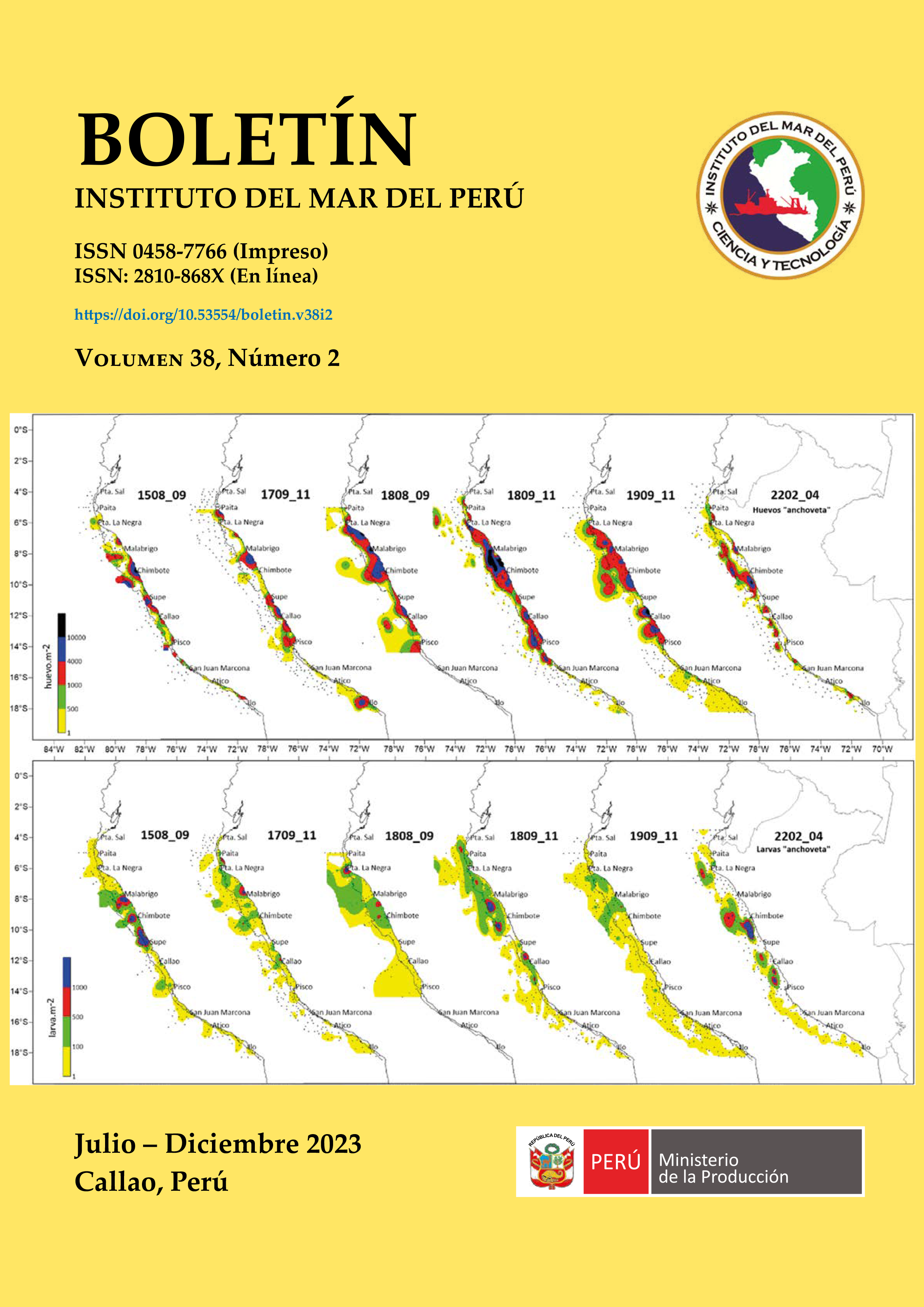Ichthyoplankton, euphausiids, and zooplankton biovolumes in the Peruvian sea (winterspring 2015)
DOI:
https://doi.org/10.53554/boletin.v38i2.387Keywords:
Engraulis ringens, Nyctiphanes simplex, Zooplankton biovolumen, Winter-spring 2015Abstract
This paper presents the results from the analysis of zooplankton samples collected during the Hydroacoustic Pelagic Resources Cruise 1508-10, conducted from August 20 to October 8, 2015, spanning from Punta Sal to Morro Sama. We identified eggs and larvae from 37 families and
51 species of ichthyoplankton. Engraulis ringens eggs and larvae were the most abundant, ranging from 3 to 14,640 eggs.m-2 and from 3 to 1,743 larvae.m-2. The primary spawning areas were along the coastal zone from Pimentel to San Juan de Marcona and off Mollendo. Additionally, there were significant larval concentrations within the continental shelf between Malabrigo and Supe. V. lucetia also showed noticeable abundances, ranging from 3 to 3,078 eggs.m-2 and from 3 to 342 larvae.m-2, distributed beyond the continental shelf. A total of 13 species of euphausiids were identified, with Nyctiphanes simplex being the most abundant and frequent species, found from Punta Sal to San Juan de Marcona. Zooplankton biovolumes ranged from 0.010 to 3.014 mL.m-3, with biovolumes less than 0.255 mL.m-3 being more prevalent (47 %), primarily in the coastal zone. The abundance and distribution of these groups were closely linked to the environmental conditions observed during the cruise.
Downloads
Alternative Metrics
Metrics
References
Antezana, T. (1978). Distribution of euphausiids in the Chile-Perú Current with particular reference to the endemic Euphausia mucronata and the Oxygen Minimum Layer. Ph. D. Dissertation, San Diego. Scripps Institution of Oceanography, University of California.
Antezana, T. (1981). Zoogeography of euphausiids of the South Eastern Pacific Ocean. En: UNESCO (ed.). Memorias del Seminario sobre Indicadores Biológicos del Plancton (pp. 5-23). Oficina Regional de Ciencia y Tecnología de la UNESCO para América Latina y el Caribe.
Ayón, P. (2000). El método de producción diaria de huevos en la estimación de la biomasa desovante del stock norte-centro de la anchoveta peruana. Bol Inst Mar Perú, 19(1-2),7-14. https://hdl.handle.net/20.500.12958/990
Ayón, P. & Buitrón, B. (2007). Biomasa desovante de anchoveta en la zona norte-centro del mar peruano (3°30’ a 15°S) durante el invierno 2007. Inf Inst Mar Perú, 34(3), 193-196. https://hdl.handle.net/20.500.12958/1954
Ayón, P., Purca, S. & Guevara-Carrasco, R. (2004). Zooplankton volume trends off Peru between 1964 and 2001. ICES Journal of Marine Science, 61(4), 478-484. https://doi.org/10.1016/j.icesjms.2004.03.027
Brinton, E. (1962). The distribution of Pacific Euphausiids. Bulletin of the Scripps Institution of Oceanography of the University of California. 8(2):51-270. https://escholarship.org/uc/item/6db5n157
Einarsson, H. & Rojas de Mendiola, B. (1963). Descripción de huevos y larvas de anchoveta (Engraulis ringens J.). Bol Inst Recurs Mar, Callao, I(1),1-23. https://hdl.handle.net/20.500.12958/64
Grupo Trabajo Institucional El Niño (GTI-EN). (2015a). Informe de las condiciones oceanográficas y biológico-pesqueras setiembre 2015. [en línea]. Instituto del Mar del Perú. Setiembre 2015. http://www.imarpe.gob.pe/imarpe/archivos/informes/imarpe_gti_infor_setie2015.pdf
Grupo Trabajo Institucional El Niño (GTI-EN). (2015b). Informe de las condiciones oceanográficas y biológico-pesqueras octubre 2015. [en línea]. Instituto del Mar del Perú. octubre 2015. http://www.imarpe.gob.pe/imarpe/archivos/informes/imarpe_gti_infor_octu2015.pdf
Guzmán, S. (2000). Breve revisión de los cambios en el desove de la anchoveta peruana entre 1966 y 1999. Bol Inst Mar Perú, 19(1-2), 1-5. https://hdl.handle.net/20.500.12958/989
Guzmán, S., Ayón, P. & Quesquén, R. (1998). Composición, distribución y abundancia del ictioplancton. Crucero BIC Humboldt y BIC José Olaya Balandra 9808-09. Inf Inst Mar Perú, 141, 72-84. https://hdl.handle.net/20.500.12958/1552
Kramer, D., Kalin, M. J., Stevens, E. G., Thrailkill, J. R. & Zweifel, J. R. (1972). Collecting and processing data on fish eggs and larvae in the California Current Region. NOAA Technical Report NMFS, Circ-370. U. S. Department of Commerce. NOAA. National Marine Fisheries Service: 38 pp. https://spo.nmfs.noaa.gov/sites/default/files/legacy-pdfs/CIRC370.pdf
Moser, H. (1996). The early stages of fishes in the California Current Region. California Cooperative Ocean Fisheries Investigations, 73(3), Atlas Nro. 33, 1505.
Palomares, M. L., Muck, P., Mendo, J., Chumán, E., Gomez, O. & Pauly, D. (1987). Growth of the Peruvian anchoveta (Engraulis ringens J.),1953 to 1982. In D. Pauly and I. Tsukayama (eds.) The Peruvian anchoveta and its upwelling ecosystem: three decades of change. ICLARM Studies and Reviews 15, 351 p. Instituto del Mar del Peru (IMARPE), Callao, Peru; Deutsche Gesellschaft fiir Technische Zusammenarbeit (GTZ), GmbH, Eschborn, Federal Republic of Germany; and International Center for Living Aquatic Resources Management (ICLARM). https://hdl.handle.net/20.500.12958/1431
Rojas de Mendiola, B. & Gómez, O. (1981). Daily otolith rings in otoliths of larval anchovy (Engraulis ringens). Rapports et Process verbaux des Reunions. Cons. Int. Explor. Mer., 178, 565-566.
Santander, H. (1987). Relationships between anchoveta egg standing stock of parent biomass off Peru, 4-14°S, p. 179-207. In D. Pauly and I. Tsukayama (eds.) The Peruvian anchoveta and its upwelling ecosystem: three decades of change. ICLARM Studies and Reviews 15, 351 p. Instituto del Mar del Peru (IMARPE), Callao, Peru; Deutsche Gesellschaft fiir Technische Zusammenarbeit (GTZ), GmbH, Eschborn, Federal Republic of Germany; and International Center for Living Aquatic Resources Management (ICLARM). https://hdl.handle.net/20.500.12958/1431
Santander, H. & Sandoval de Castillo, O. (1973). Estudio sobre la primera etapa de vida de la anchoveta. Inf Inst Mar Perú, 41, 30. https://hdl.handle.net/20.500.12958/269
Van Guelpen, L., Markle, D. F. & Duggan, D. J. (1982). An evaluation of accuracy, precision and speed of several zooplankton-subsampling techniques. Journal du Conseil International pour L’exploration de la Mer, 40, 226-236. https://doi.org/10.1093/icesjms/40.3.226
Downloads
Published
How to Cite
Issue
Section
License
Copyright (c) 2023 Boletin Instituto del Mar del Perú

This work is licensed under a Creative Commons Attribution 4.0 International License.










